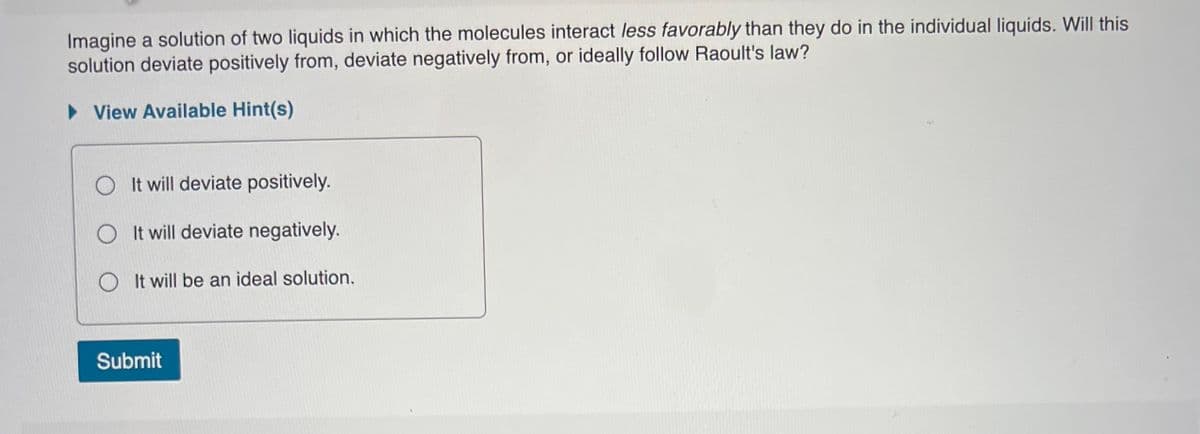Imagine a solution of two liquids in which the molecules interact less favorably than they do in the individual liquids. Will this solution deviate positively from, deviate negatively from, or ideally follow Raoult's law?
Imagine a solution of two liquids in which the molecules interact less favorably than they do in the individual liquids. Will this solution deviate positively from, deviate negatively from, or ideally follow Raoult's law?
Chapter11: Properties Of Solutions
Section: Chapter Questions
Problem 6RQ: In terms of Raoults law, distinguish between an ideal liquid-liquid solution and a nonideal...
Related questions
Question

Transcribed Image Text:Imagine a solution of two liquids in which the molecules interact less favorably than they do in the individual liquids. Will this
solution deviate positively from, deviate negatively from, or ideally follow Raoult's law?
• View Available Hint(s)
O It will deviate positively.
O It will deviate negatively.
O It will be an ideal solution.
Submit

Transcribed Image Text:How to apply Raoult's law to real solutions
Consider mixing a liquid with a vapor pressure of 100 torr with an equimolar amount of a liquid with a vapor pressure of 200 torr.
The resulting solution would be predicted to have a vapor pressure of 150 torr if it behaved ideally.
If, however, the interactions between the different components are not similar we can see positive or negative deviations from the
calculated vapor pressure. An actual vapor pressure greater than that predicted by Raoult's law is said to be a positive deviation and
an actual vapor pressure lower than that predicted by Raoult's law is a negative deviation.
Expert Solution
This question has been solved!
Explore an expertly crafted, step-by-step solution for a thorough understanding of key concepts.
This is a popular solution!
Trending now
This is a popular solution!
Step by step
Solved in 2 steps with 2 images

Knowledge Booster
Learn more about
Need a deep-dive on the concept behind this application? Look no further. Learn more about this topic, chemistry and related others by exploring similar questions and additional content below.Recommended textbooks for you


Chemistry
Chemistry
ISBN:
9781305957404
Author:
Steven S. Zumdahl, Susan A. Zumdahl, Donald J. DeCoste
Publisher:
Cengage Learning

Chemistry: An Atoms First Approach
Chemistry
ISBN:
9781305079243
Author:
Steven S. Zumdahl, Susan A. Zumdahl
Publisher:
Cengage Learning


Chemistry
Chemistry
ISBN:
9781305957404
Author:
Steven S. Zumdahl, Susan A. Zumdahl, Donald J. DeCoste
Publisher:
Cengage Learning

Chemistry: An Atoms First Approach
Chemistry
ISBN:
9781305079243
Author:
Steven S. Zumdahl, Susan A. Zumdahl
Publisher:
Cengage Learning

General Chemistry - Standalone book (MindTap Cour…
Chemistry
ISBN:
9781305580343
Author:
Steven D. Gammon, Ebbing, Darrell Ebbing, Steven D., Darrell; Gammon, Darrell Ebbing; Steven D. Gammon, Darrell D.; Gammon, Ebbing; Steven D. Gammon; Darrell
Publisher:
Cengage Learning

Chemistry: Principles and Practice
Chemistry
ISBN:
9780534420123
Author:
Daniel L. Reger, Scott R. Goode, David W. Ball, Edward Mercer
Publisher:
Cengage Learning

Principles of Modern Chemistry
Chemistry
ISBN:
9781305079113
Author:
David W. Oxtoby, H. Pat Gillis, Laurie J. Butler
Publisher:
Cengage Learning